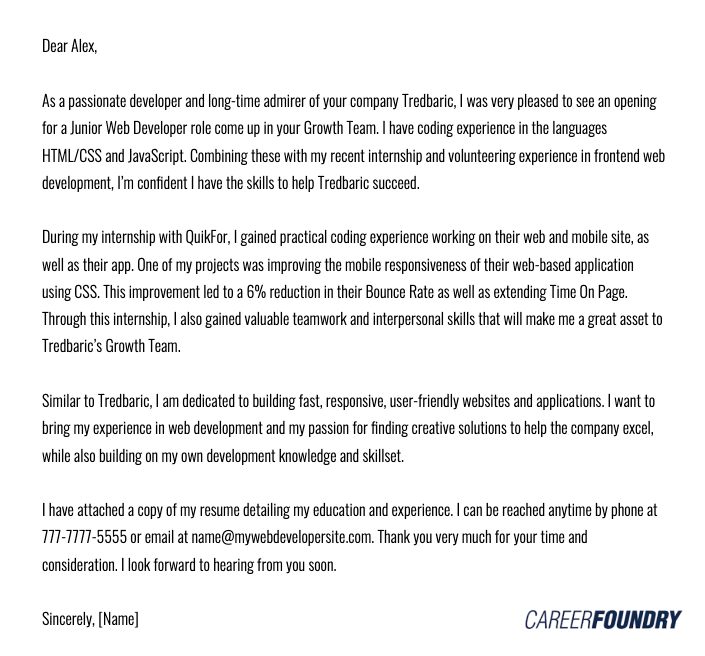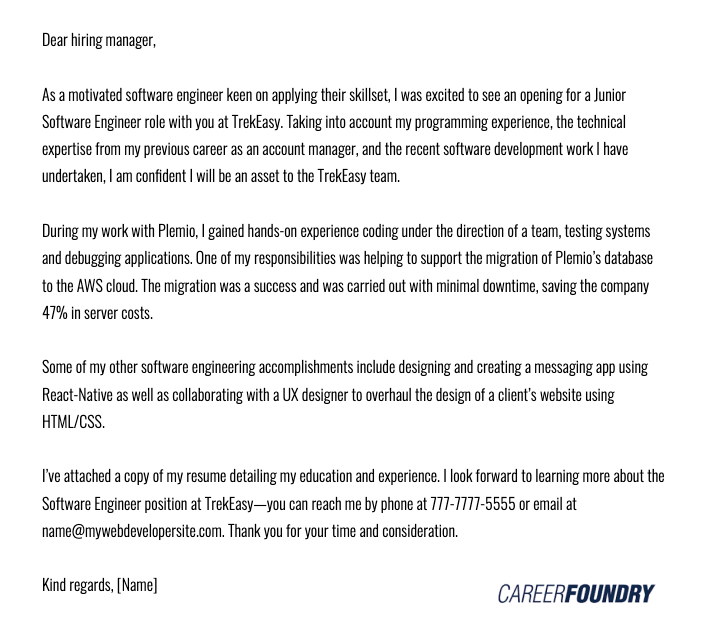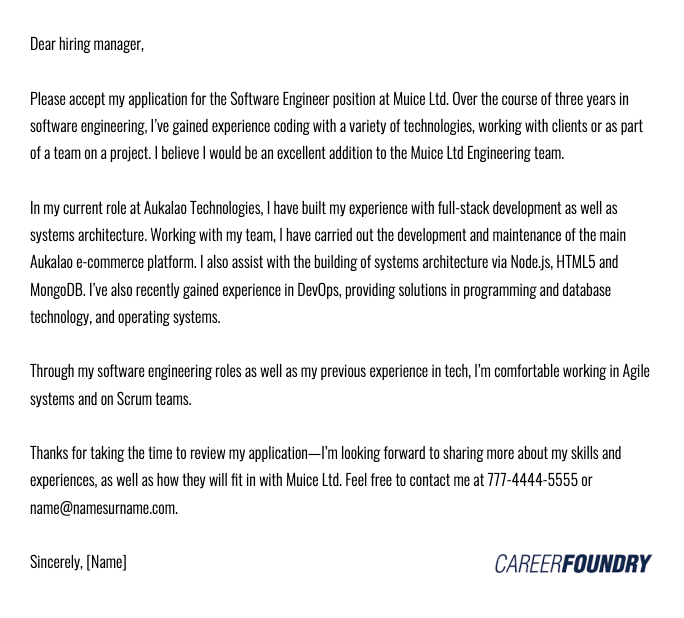You’ve completed your certification and are now on the lookout for a well-paying software engineering job at a competitive company, but it’s daunting to get a foot in the door for an interview.
How do you flex your newfound skills and get noticed, standing out from the cascade of application packets that fall on a hiring manager’s desk (or their inbox)?
Here’s an opportunity to breathe life and personality into your job hunt: the software engineer cover letter.
Think of your application as an ecosystem, one that contains a cover letter, resume, and portfolio. Each piece relies on another to further tell different facets of a story, the story of you. Each is symbiotic to the other two, forming the entire narrative of who you are. For an application to flourish, each must individually thrive and support the other.
While we will be covering the cover letter, it’s only one third of your presentation. You can also find a complete software engineer resume guide for some extra CV spice!
If you’d like to skip ahead to a particular section, simply use the the clickable table of contents:
- Software engineer cover letter FAQs
- How to write a software engineer cover letter
- Software engineer cover letter examples
- Three tips for writing a great software engineer cover letter
1. Software engineer cover letter FAQs
Should I write a software engineering cover letter?
The short answer is yes, absolutely! You should always write a cover letter when applying to software engineering jobs. A cover letter adds depth, context, and nuance in conjunction with your resume and software engineer portfolio. It allows your tone and voice to be heard, adding a human layer to the process.
The job market for software engineering can be quite competitive, with tons of applications bombarding recruiters. According to ResumeLab, 77% of recruiters said that they give preference to those applicants that submit a cover letter, saying further that it helps demonstrate that you’d be a good fit at a company. A cover letter can make an application packet pop and be the determining factor in getting you in the door.
What should you include in a software engineer cover letter?
When it comes to what should be included, think of what your resume and portfolio are unable to say about you. These should be essential details.
The list of necessities is actually quite short:
- Greeting that’s ideally tailored to the hiring manager
- Introduction with an enticing hook that’s also like an elevator pitch
- Body with further information tailored to a business’s pain points
- Conclusion containing a strong call to action
How long should a software engineer cover letter be?
You don’t want a cover letter to be too long, so be sure to write no more than a single page; aim for a sweet spot of around 4 or 5 short paragraphs or less.
We’re looking to efficiently tell a story about who you are in the context of your experience displayed on your portfolio and resume. Think of how that story would fit into the company that you’re applying to.
2. How to write a software engineer cover letter
This is where we touch on the nitty-gritty of writing the document.
Before you start writing, deeply research the companies that you plan on applying to. This lets you tailor your information to exactly what they’re looking for. Good research shows that you have both enthusiasm as well as the capacity to dig deeply.
Throughout the document, be sure to mention transferable skills that you’ve picked up along the way. They’re looking for an experienced Software Engineer, of course, but there are soft skills that aren’t mentioned in the job description. Specifically lean into those skills that you learned in your last job.
According to Indeed on what are soft skills: “soft skills … relate to how well you can work with and interact with others.”
Write in the structure and tone of a letter; the document should include an introduction, body, and conclusion.
Introduction
Be sure to include a greeting that’s targeted toward the hiring manager, preferably by name.
In the introduction, you’ll want an enticing hook to draw the reader in and keep them engaged; get them looking forward to the body and conclusion. Make them want to see the call to action. Remember, in this story, the hiring manager’s your audience.
Think of your intro as an elevator pitch, covering the most important information as succinctly as possible. What’re the essential points that you can get across in that first paragraph? While we’ve made the letter skimmable, be prepared for the reader to only read or remember the introduction.
Body
This is where the bulk of your data is, spanning 2 to 3 short paragraphs. Detail how your experience, especially your soft skills, will be vital to the company that you’re applying to.
Ideally you’ve found a company’s history and pain points; this is where you can insert your experience to meet those needs. Be sure to align your skills with each qualification mentioned in the job posting.
When mentioning work that’s on your resume, it’s always helpful to talk about the last job that you’ve held to display the information that’s still fresh. It may be helpful to include specific, relevant projects that you’ve worked on in the past.
Expound on any major accomplishments that you have, providing quantifiable data where applicable. Data driven points can turn a sentence from, “I saved SoftwareBusiness Inc. a lot of money,” into, “I saved Engineers LLC $7,000 in Q1 2023 by…” Specific metrics highlight the outcomes to hiring you.
Conclusion
This is the story’s resolution! We’ve so far hammered through the introduction and body, but it’s essential that we not go light on this conclusion.
This is a space to reiterate how you would be a perfect fit for the job opening. Briefly thank them for reading. Deliver a strong call to action that encourages them to follow-up with you and hire you for the position.
3. Some software engineer cover letter examples
One of the best ways to compose a cover letter is to look at examples that already exist and apply what you’ve learned. Here are some examples we’ve whipped up:



4. Three tips for writing a great software engineer cover letter
While these aren’t essential components, these three tips will help you compose and polish a strong software engineer cover letter to wow your way into a new job.
- Find patterns in companies in order to expedite the composing process for multiple letters. If applying to a lot of jobs, it may be helpful to find some common threads that exist between them and write to that. When you’re sending one out, you can alter a few details to match that specific company.
- Take some time to iterate with fresh eyes. We tend to have a few hours of good writing in us a day. Seeing your piece anew may help in picking up mistakes that you have looked over or think of new ideas. Think of writing in the way a sculptor would see a piece of marble. The finished sculpture is in there, and each time you visit, it comes more and more into shape.
- Make the document skimmable. As we’ve touched on a few times, hiring managers usually see a lot of applications. Emphasizing and highlighting key points will improve the odds that they see the information that you value the most.
5. Final thoughts
It’s taken a lot of work to get through your coding bootcamp, and the job hunt is still before you! A good cover letter can make or break an application to a hiring manager overwhelmed by packets. After learning how to effectively write a cover letter, you’ll have an edge over your counterparts.
Again, think of your cover letter as a facet of your application ecosystem. What are the things that are important for you to communicate that neither your resume nor portfolio can convey? How can you support your resume and portfolio through communicating your ideas efficiently and with data-driven metrics?
When embarking on the job hunt, having someone to help show you the way can make all the difference. That’s why when students of CareerFoundry’s Full-Stack Web Development Program reach the end of their studies, they get paired up with a career specialist. You’ll work closely with them to connect the dots between your previous accomplishments with your newfound coding skills.
Together, you’ll create a winning software engineer resume that showcases your talent, and carefully craft your online presence to appeal to tech employers. You’ll also fine-tune your interview skills, learning how to confidently market your experience and to prepare for the recruiter phone screen.
If you are interested in reading further about improving your chances during the hiring process for software engineers, check out some of our other articles:
